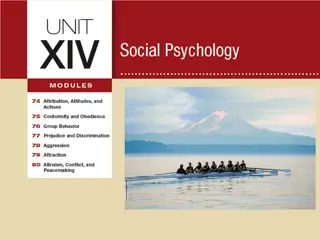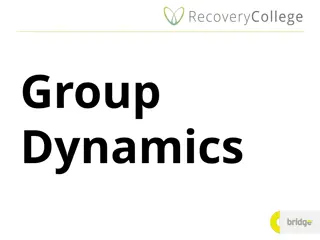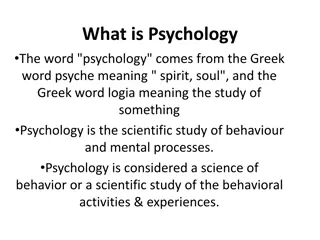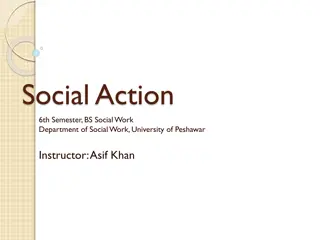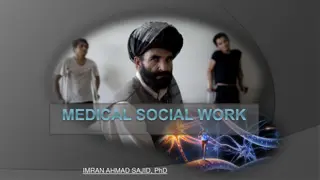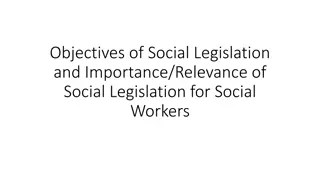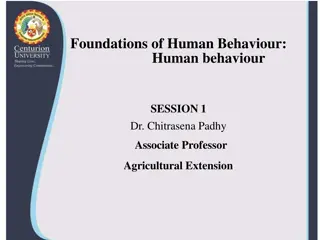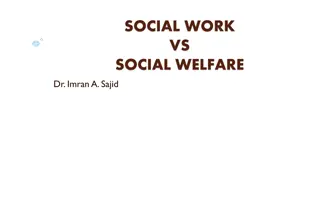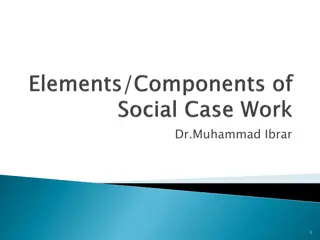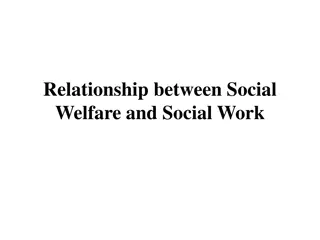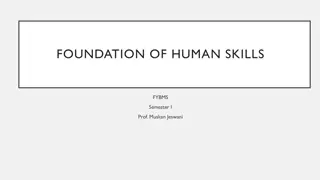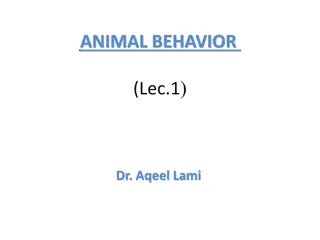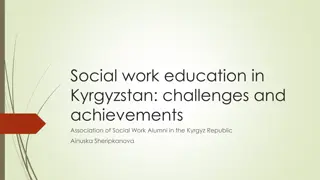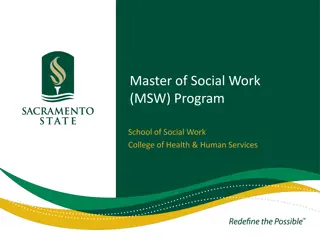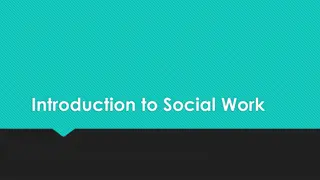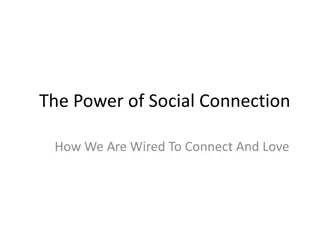Understanding Social Loafing in Human Behavior at Work
Social loafing is a phenomenon where individuals exert less effort in a group setting than when working alone, leading to decreased productivity. In organizations, this behavior can hinder overall group performance and create issues such as the Free-Rider Effect and Sucker Effect. Recognizing and addressing social loafing is crucial for building an efficient and motivated workforce.
Download Presentation

Please find below an Image/Link to download the presentation.
The content on the website is provided AS IS for your information and personal use only. It may not be sold, licensed, or shared on other websites without obtaining consent from the author. Download presentation by click this link. If you encounter any issues during the download, it is possible that the publisher has removed the file from their server.
E N D
Presentation Transcript
CLASS : BBA-II SEMESTER IV SUBJECT : HUMAN BEHAVIOUR AT WORK TOPIC : SOCIAL LOAFING AND SOCIAL FACILITATION MADE BY : SONIA DHINGRA I.B. (PG) COLLEGE, PANIPAT AFFILIATED TO KURUKSHETRA UNIVERSITY, KURUKSHETRA
SOCIAL LOAFING In social psychology, social loafing is the phenomenon of a person exerting less effort to achieve a goal when he or she works in a group than when working alone and is seen as one of the main reasons groups are sometimes less productive than the combined performance of their members working as individuals. The idea of working in groups is typically seen as a way to improve the accomplishment of a task by pooling the skills and talents of the individuals in that group. But, in some groups, there is a tendency on the part of participants to contribute less to the group's goal than if they were doing the same task themselves.
Social loafing refers to a psychological phenomenon which has brought forward a different side of human resource. It states that the employees working in a group, underperform a given task in comparison to their potential, ultimately hindering the group performance. This is because they develop a casual attitude towards the assigned responsibilities by putting in their least contribution and thus, relying upon the efforts of other team members. he concept of social loafing or Ringlemann effect has denied a traditional belief that people tend to perform better when they work as a team . Max Ringlemann, a French engineer, carried out the rope pulling experiment. He discovered that, when the participants were asked to pull the rope in groups of two, three and eight, they put in fewer efforts; as compared to when they were individually pulling the rope. Thus, Ringlemann came up with this concept of social loafing in the year 1913.
TYPES OF SOCIAL LOAFING Social loafing is a hurdle in the productivity of any organization. The management must address the issue of social loafing to develop an efficient workforce in the organization. Let us now see the two significant ways in which social loafing takes place in an organization:
Free-Rider Effect : Sometimes, one or more team members possess a casual attitude towards the group goals, feeling that their contribution to the task is not that compulsory. Since the other members will now solely accomplish the given project, it is termed as the free-rider effect. Such social loafers are considered as free-riders. Sucker Effect : Due to the free-rider effect, the other members of the group or team feel overloaded with work. This is because they now have to do the task of such free-riders too, without getting any additional recognition. Thus, the other team members get demotivated and feel sucked at their job. These active members also disengage themselves from work, sensing their exploitation by social loafers. This is known as the sucker effect of social loafing
CAUSES OF SOCIAL LOAFING What are the reasons which can be held responsible for social loafing in an organization? Why do the organization face such a problem? This issue is deeply rooted in the organizational factors and group formations. Discussed below are some of the causes of this social psychology phenomenon:
1. Complex Goals: The individuals usually give up when they feel that the goals set by the management are robust and impossible to achieve. 2. Easily Achievable Goals: If the goals set are simple enough and does not pose any challenge for the employees, they tend to feel demotivated. Thus, showing minimal interest in achieving them. 3. Goal Value: If the team members feel that the goals or objectives laid for them have no significance and won t add any value to the organizational objectives; they will try to slack off from the given task. 4. Lack of Motivation: The demotivated workforce is another primary reason for social loafing where the employees are not charged up to fulfil the given responsibility.
5. Large Group Size: At times, the group or team consist of more number of individuals than required. Therefore, surplus members tend to become unproductive and waste their time in social loafing. 6. Sense of Inferiority: The team members who are less skilled or average performers are sometimes put in the group of super achievers. This will develop an inferiority complex, resulting in average employees depending upon the efficient team members for task accomplishment. 7. Lowered Sense of Efficacy: When the individuals feel that their efforts are undervalued or ignored, they find it better to escape from their responsibilities through social loafing. 8. Meagre Sense of Responsibility: If the employees are not made individually accountable for the given task, they would be reluctant of their duties and responsibilities. Moreover, they will prefer to rely upon those who hold accountability to accomplish the assigned responsibility.
EFFECTS OF SOCIAL LOAFING EFFECTS OF SOCIAL LOAFING Social loafing creates a negative impact on the performance of the group and thus slowing down the productivity of the whole organization. Let us now understand the various adverse effects which it has on the organization:
1. Leads to Poor Team Spirit: If few members become lazy and reluctant, making the least contribution in the group, the whole team feels demotivated and demoralized. 2. Portrays Negativity: The escaping attitude of social loafers spread negativity in the whole group. It thus brings down team performance and productivity. 3. Hinders Development: The growth of the organization gradually falls if social loafing continues for a long time. 4. Causes Wastage of Resources: The human resource involves cost, and because of social loafing, the employees become futile for the organization. 5. Demotivates Hard Working Team Members: Due to free-riders effect and sucker effect, the performing team members get demoralized. Hence they too try to slack off from the assigned task considering it as a burden. 6. Affects Decision Making: Without proper input from all the group members, the group s decision making efficiency diminishes.
HOW TO PREVENT SOCIAL LOAFING? HOW TO PREVENT SOCIAL LOAFING? Social loafing not only hinders the team performance but also leads to downfall in the competitiveness and growth of the organization. Therefore, it is essential to encounter and deal with such activities.
Following are some of the measures which can be adapted to disrupt social loafing in an organization: 1. The management must frame the tested goals and objectives which are possible to be accomplished within a given period and but also challenges the group efforts. Moreover, these goals should be simple to understand and well explained to every individual. 2. The group performance should be regularly evaluated under the benchmarking strategy and then comparing it with the standards set or the past performance to fill the gap. 3. The groups or teams should be formed wisely by including a limited number of individuals; also, there should be a group orientation to develop unity and team spirit among them. 4. Specify the contribution of each employee in goal accomplishment, by defining his/her task, roles and responsibilities to provide individual recognition. 5. Regular feedback sessions should be carried out to monitor the work of each in a team, along with taking up colleague s review on individual performance through a collegial feedback process.
There should be an open communication system in the organization. The individuals should feel free to put up their problems or queries in front of the management. It develops a scope of improvement in their overall efficiency. 6. If the individual efforts are assisted and necessary steps are taken to solve their problems, they tend to improve their performance while working in a group. 7. The team constitutes of individuals, and if each will be aware of his/her duties and responsibilities in achieving a group objective, it will keep them engaged. 8. The employees must be placed in a group or team by analyzing the individual skill sets and matching it with that required for the achievement of desired group goals. It ensures proper utilization of the human resource. 9. Social loafing can be easily identified if the manager regularly takes round in the work area. It would help him/her to figure out the behaviour, attitude, contribution and participation of each individual, during the group activities and team efforts.
SOCIAL FACILITATION SOCIAL FACILITATION Social facilitation is defined as improvement in individual performance when working with other people rather than alone. In addition to working together with other people, social facilitation also occurs in the mere presence of other people. Previous research has found that individual performance is improved by coactions, performing a task in the presence of others who are performing a similar task, and having an audience while performing a certain task. An example of coactions triggering social facilitation can be seen in instances where a cyclist's performance is improved when cycling along with other cyclists as compared to cycling alone. An instance where having an audience triggers social facilitation can be observed where a weightlifter lifts heavier weight in the presence of an audience. Social facilitation has occasionally been attributed to the fact that certain people are more susceptible to social influencing with the argument that personality factors can make these people more aware of evaluation.
The YERKES DODSON LAW when applied to social facilitation, states that "the mere presence of other people will enhance the performance in speed and accuracy of well- practiced tasks, but will degrade in the performance of less familiar tasks. Compared to their performance when alone, when in the presence of others they tend to perform better on simple or well-rehearsed tasks and worse on complex or new ones. The audience effect attempts to explain psychologically why the presence of an audience leads to people performing tasks better in some cases and worse in others. This idea was further explored when some studies showed that the presence of a passive audience facilitated the better performance of a simple task, while other studies showed that the presence of a passive audience inhibited the performance of a more difficult task or one that was not well practiced, possibly due to psychological pressure or stress.
MAJOR EMPIRICAL FINDINGS 1. Age : In 1898, Norman Triplett pioneered research on social facilitation by studying the competitive nature of children. In this study, each child was given a string and was told to wind it. He found that children performed much better while they were competing with one another, and further research led Triplett to theorize that the presence of others increases individuals' performances in other non-competitive situations as well. In 1973, Chapman ran an experiment and found that levels of laughter among 7 8 year-old children were highest when two children listened to funny material together (coaction condition). Furthermore, levels of laughter were higher when one child listened to funny material in the presence of another child (audience condition) than when one child listened to the funny material alone (alone condition). These results indicate that laughter is also socially facilitated.
2. Prejudice : Prejudice is often considered as easily learned and performed response. Therefore, following the logic of Zajonc's drive theory of social facilitation, prejudice then, is also likely to be socially facilitated. That is, individuals may be more likely to express prejudicial views in presence of others than in private. 3. Gender : In 1994, De Castro demonstrated that social facilitation affects food intake by extending the time spent eating a meal. His results also showed that the presence of family and friends, in comparison with the presence of mere companions, increases food intake to a greater degree, possibly due to the "release of inhibitory restraints on intake" that occurs when people feel more comfortable around people they are familiar with. Furthermore, males ate 36% more food when with other people than when alone, and females ate 40% more food when with other people than when alone.
De Castro attributes this to the time-extension model of social facilitation, as the time spent at a meal increased when the meal was a social occasion. These results suggest that the presence of other people at a meal increases intake by extending the time spent at the meal, probably as a result of social interaction, and that family and friends have an even larger effect, probably by producing relaxation and a consequent disinhibition of restraint on intake. Furthermore, these results also suggest that social facilitation has very similar effects on both men and women. 4. Performance : In 1920, when asked to write out as many words as possible in response to a given word, 93% of participants produced more words in the presence of another person than alone. However, when this study was replicated with individuals who stuttered when they spoke, 80% of the participants produced more words when alone rather than in the presence of another person.
5. Animals : Social facilitation in animals is when the performance of a behaviour by an animal increases the probability of other animals also engaging in that behaviour or increasing the intensity of the behaviour. In 1969, Zajonc, Heingartner, and Herman demonstrated that social facilitation occurs not only in humans, but also in species with limited or no cognitive processing. They observed that it takes a cockroach a longer time to complete a complex maze in the presence of other cockroaches than when alone. They also observed that in a simple, straight runway, a cockroach reaches the end of the runway faster in the presence of other cockroaches than when alone. This experiment lends support to the theory that physiological arousal resulting from the presence of others leads to similar social facilitation effects in animals as well. In 2009, Dindo, Whiten, and de Waal studied the effect of social facilitation in capuchin monkeys. The monkeys in this study were required to complete a new foraging task, either alone or in a social group. While both sets of monkeys completed the task, those in the social group completed it three times faster than those monkeys that were alone. This increase in speed was attributed to "observational learning and synchronization of behavior between group mates."
ELECTRONIC PERFORMANCE MONITORING ELECTRONIC PERFORMANCE MONITORING Researchers have used electronic performance monitoring (EPM) to examine the effects of social facilitation. This trend had previously been limited to face-to-face or group settings, but electronic performance monitoring establishes the impact of social facilitation in a virtual sense. EPM is the utilization of information technologies (e.g. computer networks) to track, evaluate, analyze, and report information regarding an employee's performance. Many businesses have adopted this method in which workers activity is automatically monitored throughout the workday. This topic is of substantial interest to those in the field of social psychology due to underlying mechanism at work; namely, the phenomenon of social facilitation. One study found that EPM did enhance productivity, but only in ways that are consistent with the effects of social facilitation. Employees working on a data entry task were monitored while working alone, with others, or as part of a cohesive group. Results indicated that EPM improved the performance of highly skilled workers, but interfered with the performance of those who were less skilled
Moreover, with the exception of those working in a cohesive group, monitoring was found to increase workers' feelings of stress and anxiety. On the other hand, participants responded more favourably to performance monitoring when they believed that they could turn off the monitoring and that only their job-related activities were being evaluated. Also, EPM was viewed more positively when workers were given the opportunity to participate in decisions regarding the use of the system. Results support that the effect of social facilitation is not just limited to the physical presence of others, but also extends to presence in a virtual sense as well. In 2009, Thompson, Sebastienelli and Murray conducted an experiment to determine the effect of electronic monitoring on students who used web-based training to learn new online search skills. They found that participants who were explicitly told that their training was being monitored performed markedly worse on a post-training skills test than participants who were unaware that their training was being monitored. These findings adhere to the basic premise of social facilitation and reveal that the heightened awareness of evaluation on complex tasks significantly hinders performance.
IN EDUCATIONAL SETTINGS Groups are formed in a variety of educational settings around the world. Some examples include a group of physics students completing a laboratory exercise, a team of touch rugby players, a set of high school prefects, a group of students formed to brainstorm ideas for energy saving techniques and study groups. Some groups enhance members' motivation and help students stay focused on their academic goals.However, a study group may inhibit the acquisition of new information, concepts, and skills, as the presence of others can be distracting. These distractions can interfere during the early phases of learning, both in overt and covert practicing. In a study in which participants had to learn a list of words, they were too embarrassed to rehearse the material out aloud and as a consequence of this group pressure, their performance suffered. Zajonc suggested that the student study alone, preferably in an isolated cubicle, and arrange to write examinations surrounded by many other students, on stage, and in the presence of a large audience. The results of the examination would be beyond the student's wildest expectations, assuming that the material had been thoroughly learned beforehand.
CONTRIBUTING FACTORS Contributing factors to the audience effect could include what kind of crowd is present, such as a supportive crowd (e.g., the crowd at a team's home ground) or a hostile crowd (e.g., the crowd when a team is playing an away game). Also, the proximity of the crowd or the size of the crowd could influence the result of the audience effect. More factors such as nature of the task, coping skills with potential negative effects of audience, and even the playing venue (home or away) could be things to consider when examining the audience effect. Social facilitation is a widespread phenomenon in society. Many public tasks demonstrate the effects, both the costs and benefits, of social facilitation. From taking exams in a high school or college environment to performing in sporting events, people may perform better or fall short depending on the task's complexity. In many experiments, people display signs of social facilitation even in everyday tasks, such as driving. This effect can even be seen in animals, as displayed by Zajonc, Heingarter, and Herman's study on cockroaches.
Business can also use social facilitation to their advantage, specifically in online auctions, which takes into the account the emergence of instant messaging and communication availability technologies. The interaction between buyers and sellers in traditional, face-to-face markets creates phenomena such as social facilitation, where the presence of others impacts behaviour and performance. In the study involving Java-based Internet Dutch auction, the findings indicated that social facilitation does indeed occur and participants improve their results and stay longer in the auction under conditions of higher virtual presence. Participants also indicate a preference for auction arrangements with higher degrees of virtual presence.


